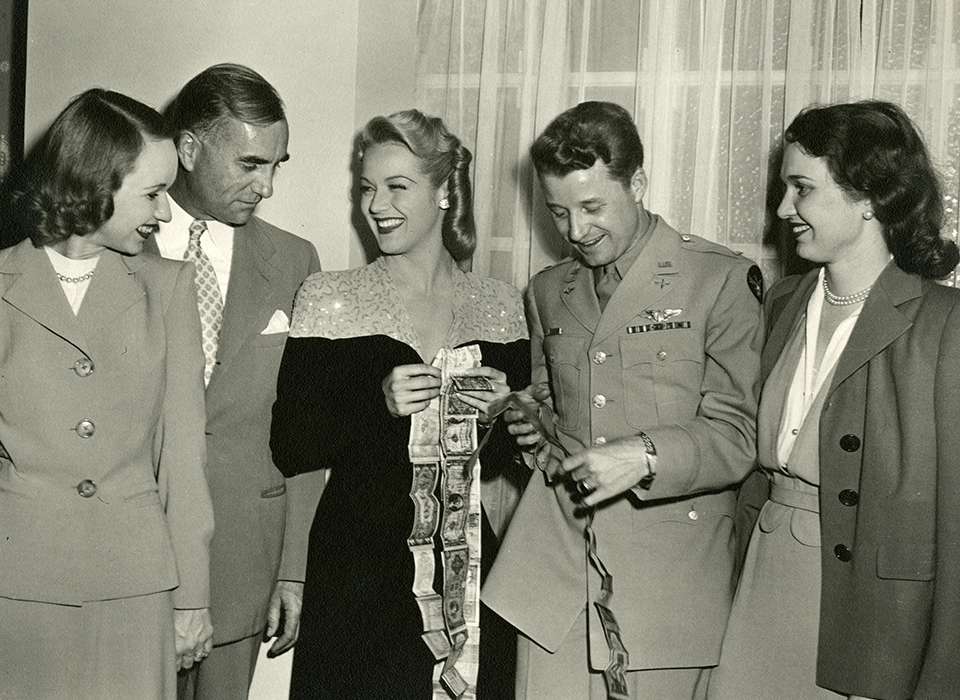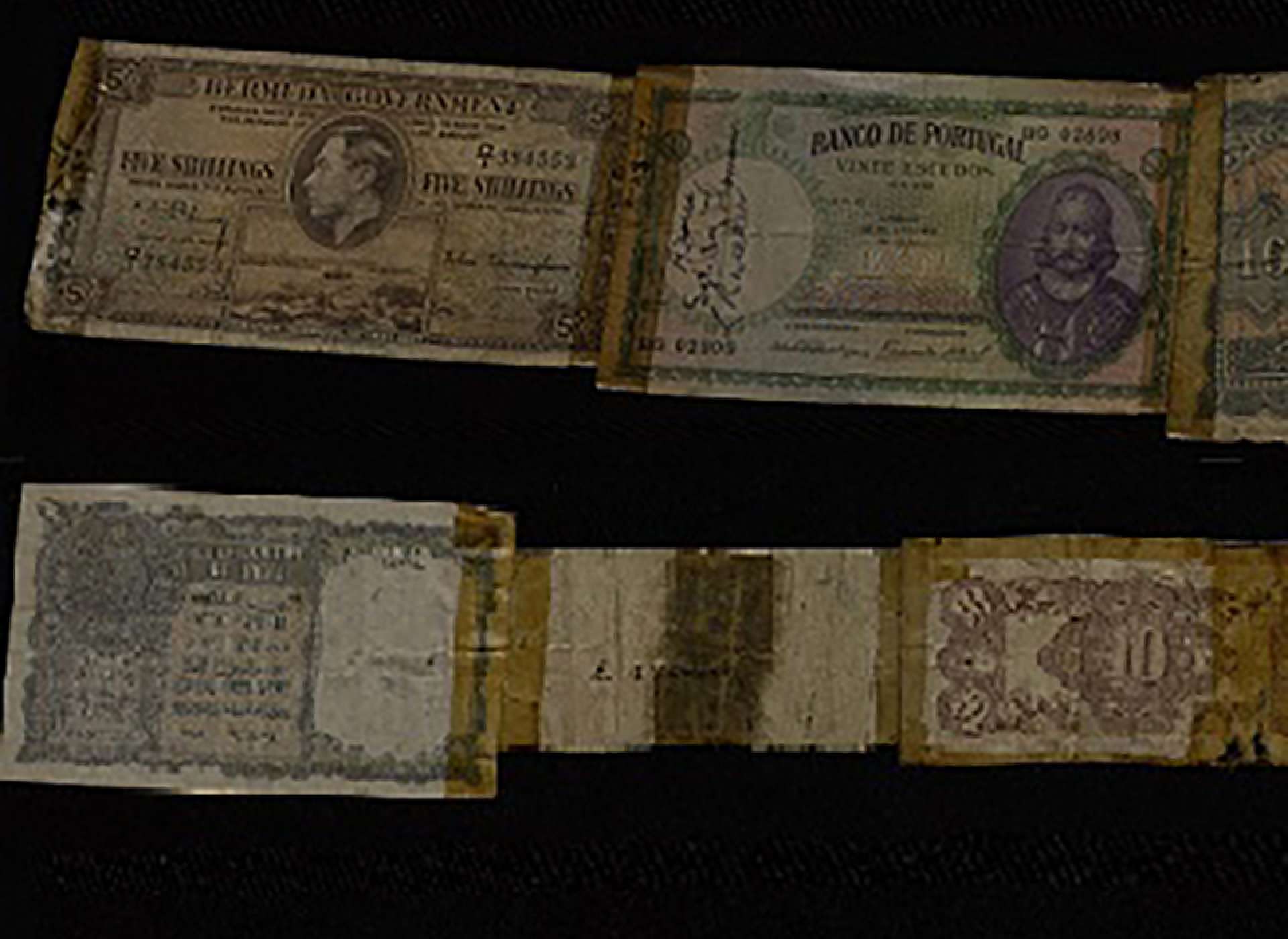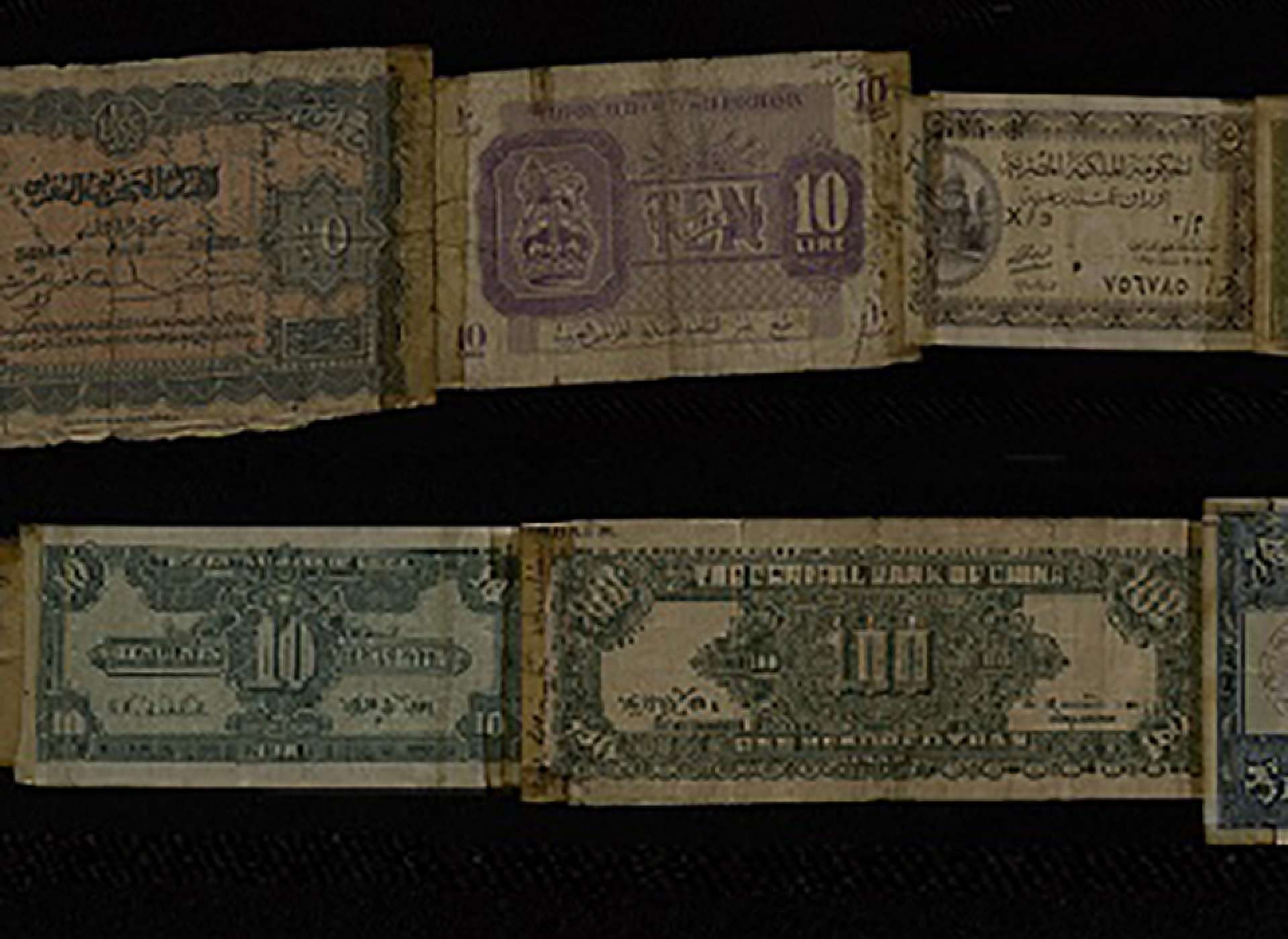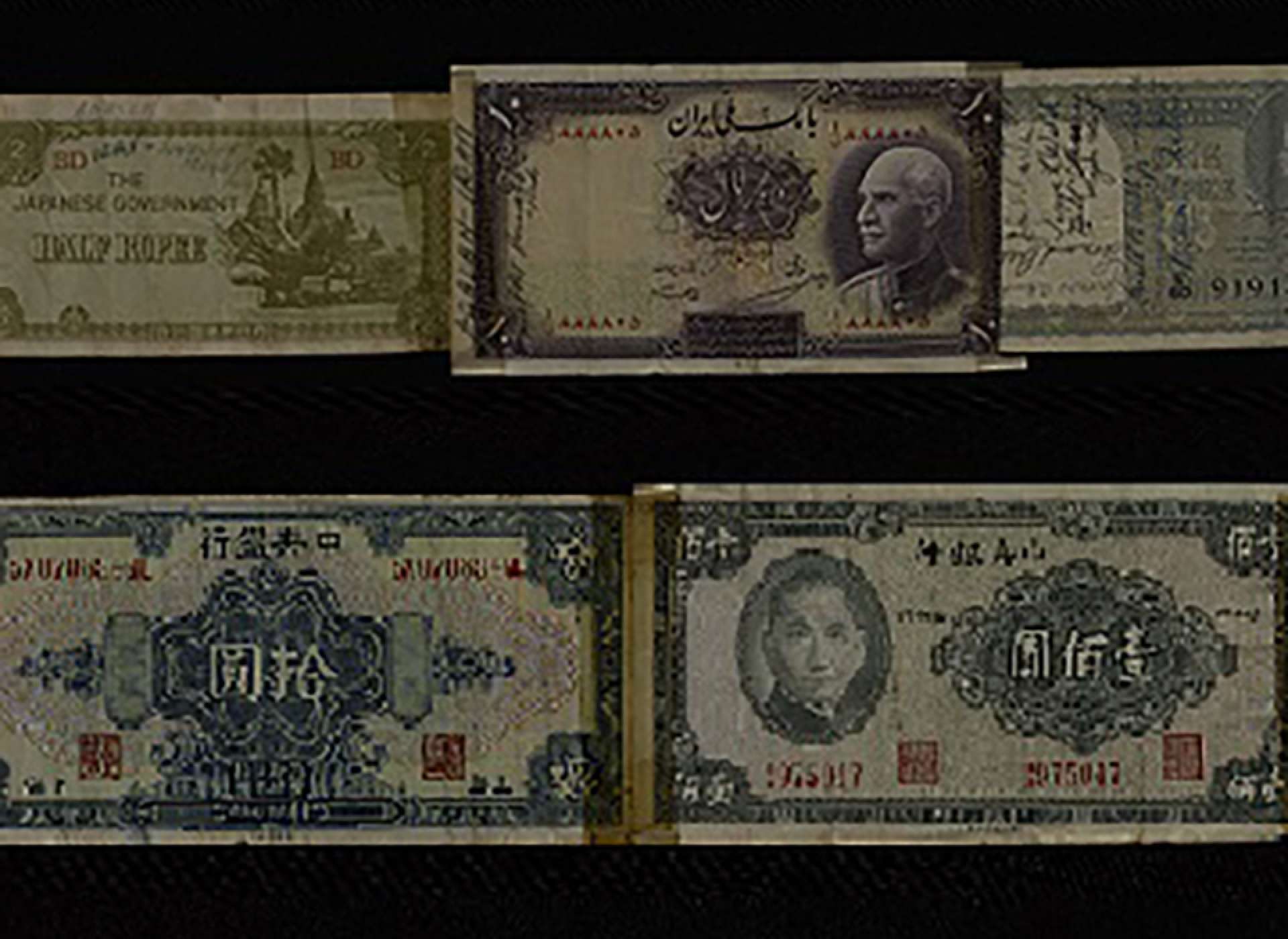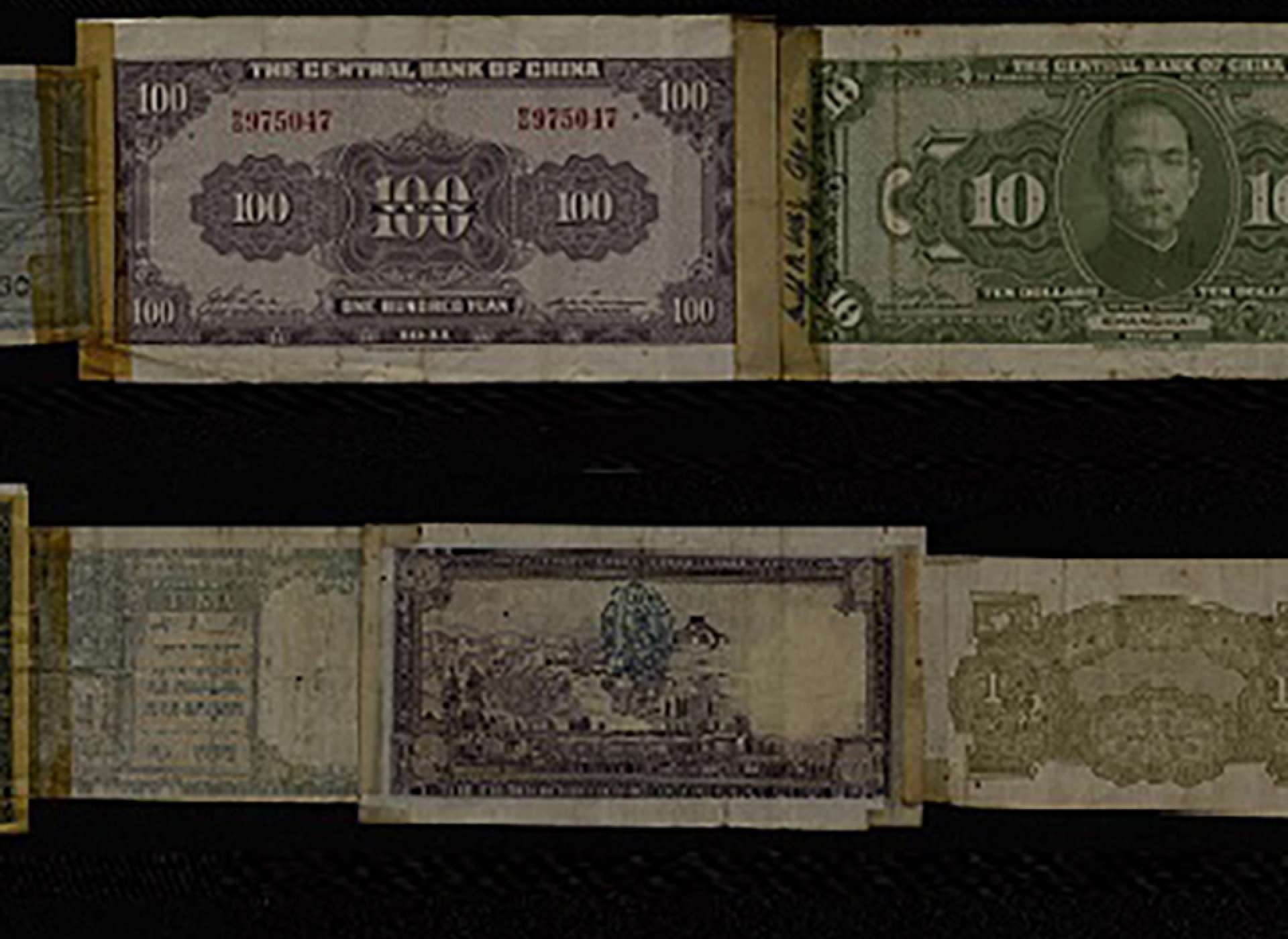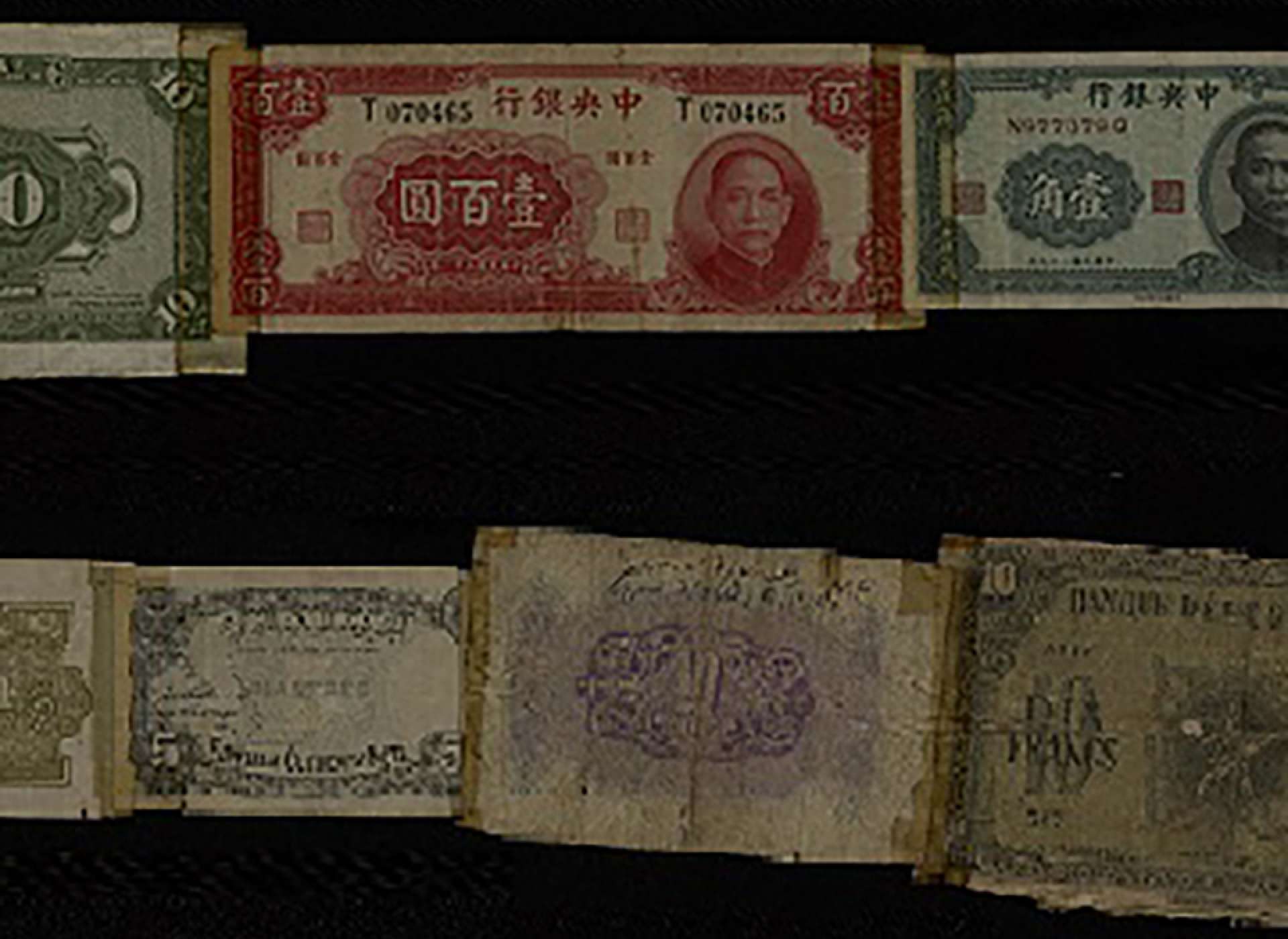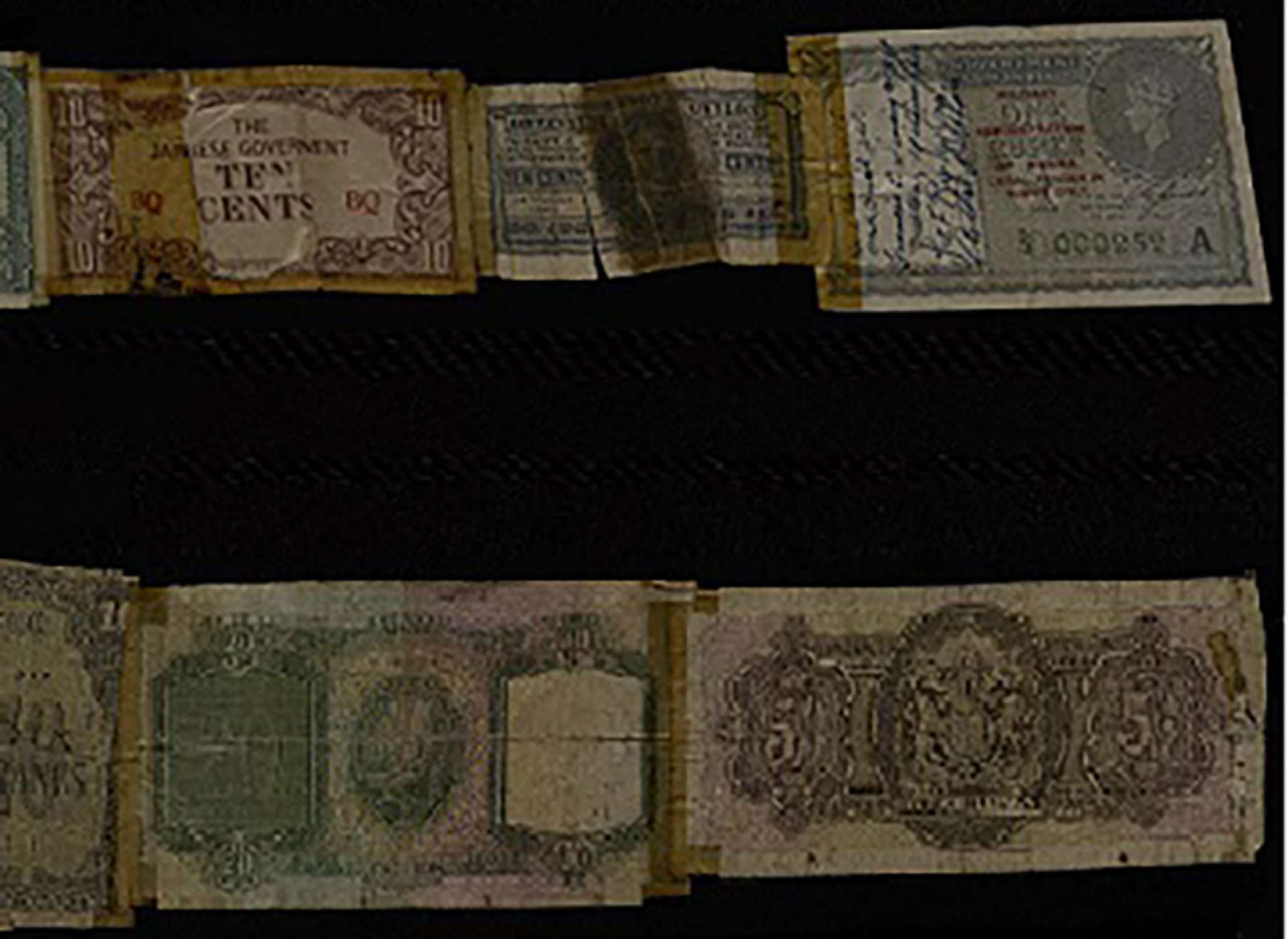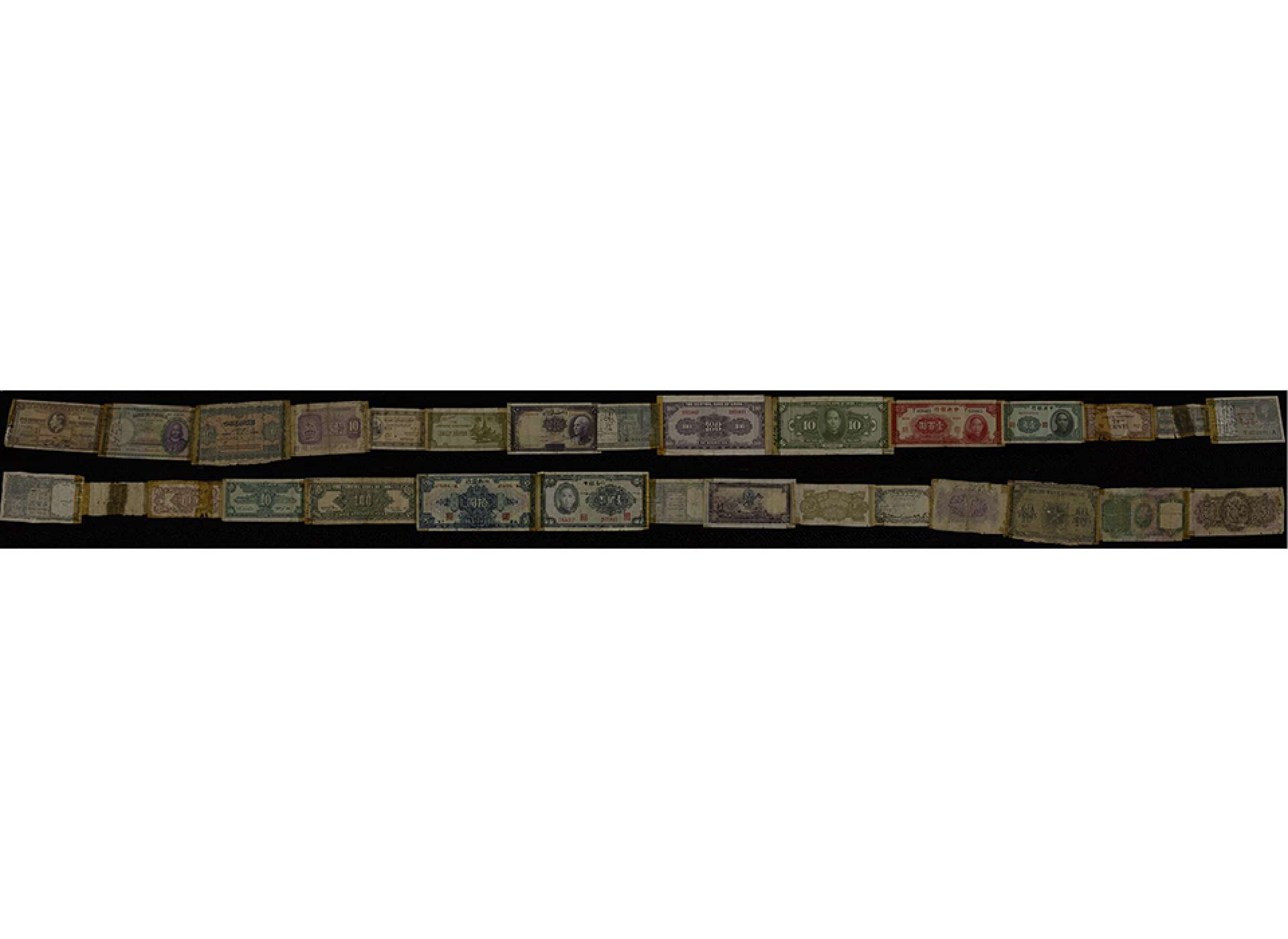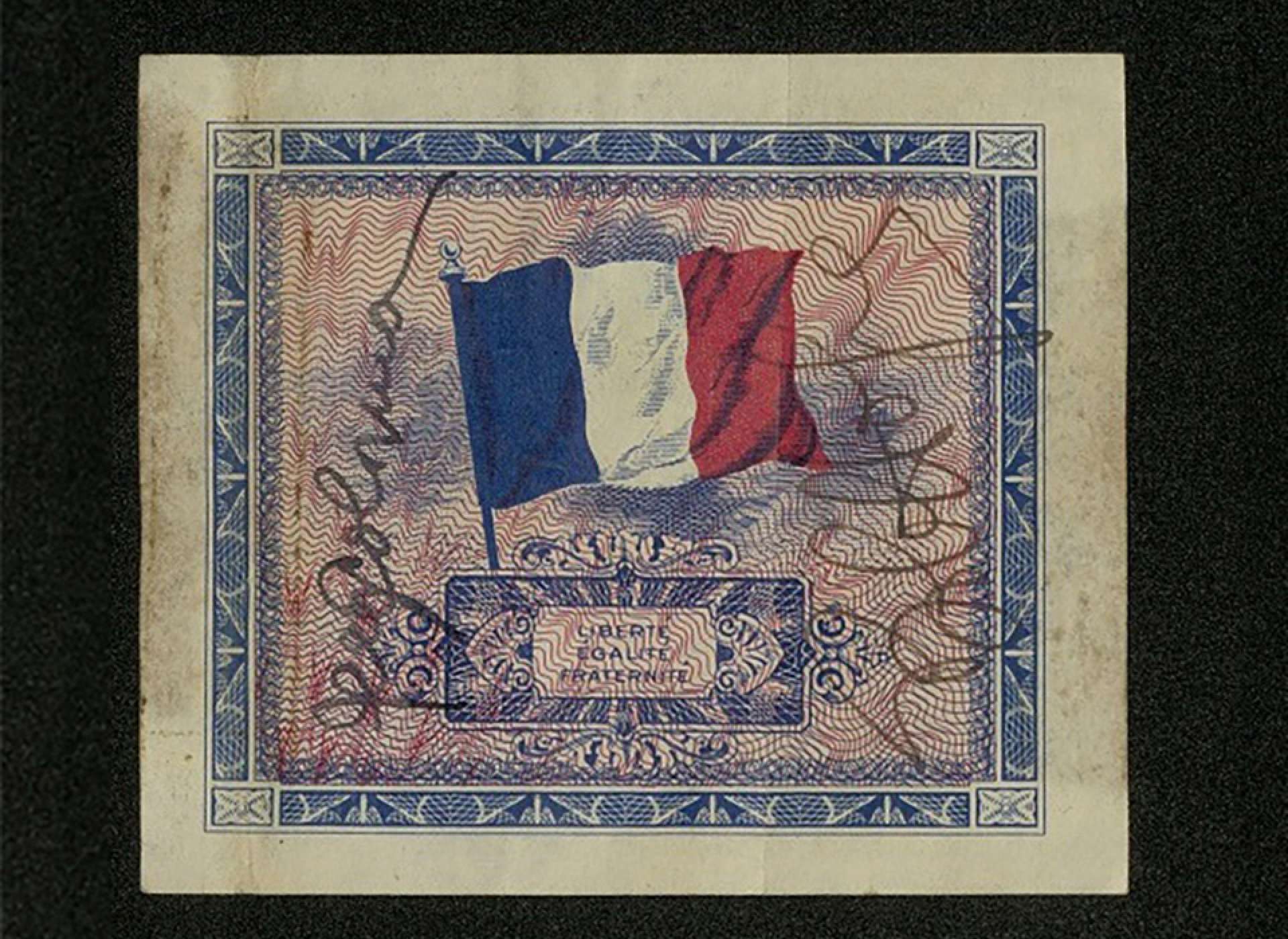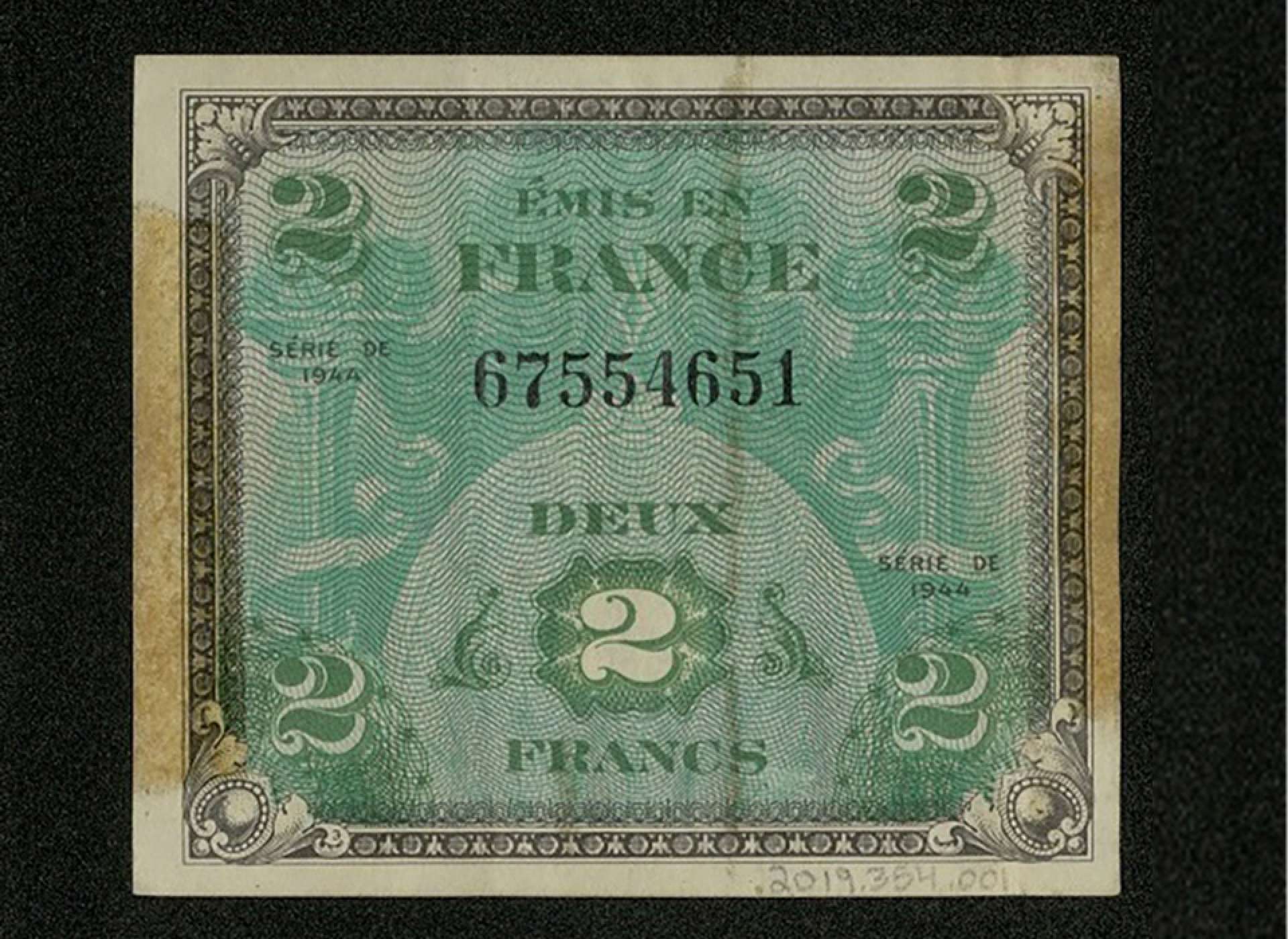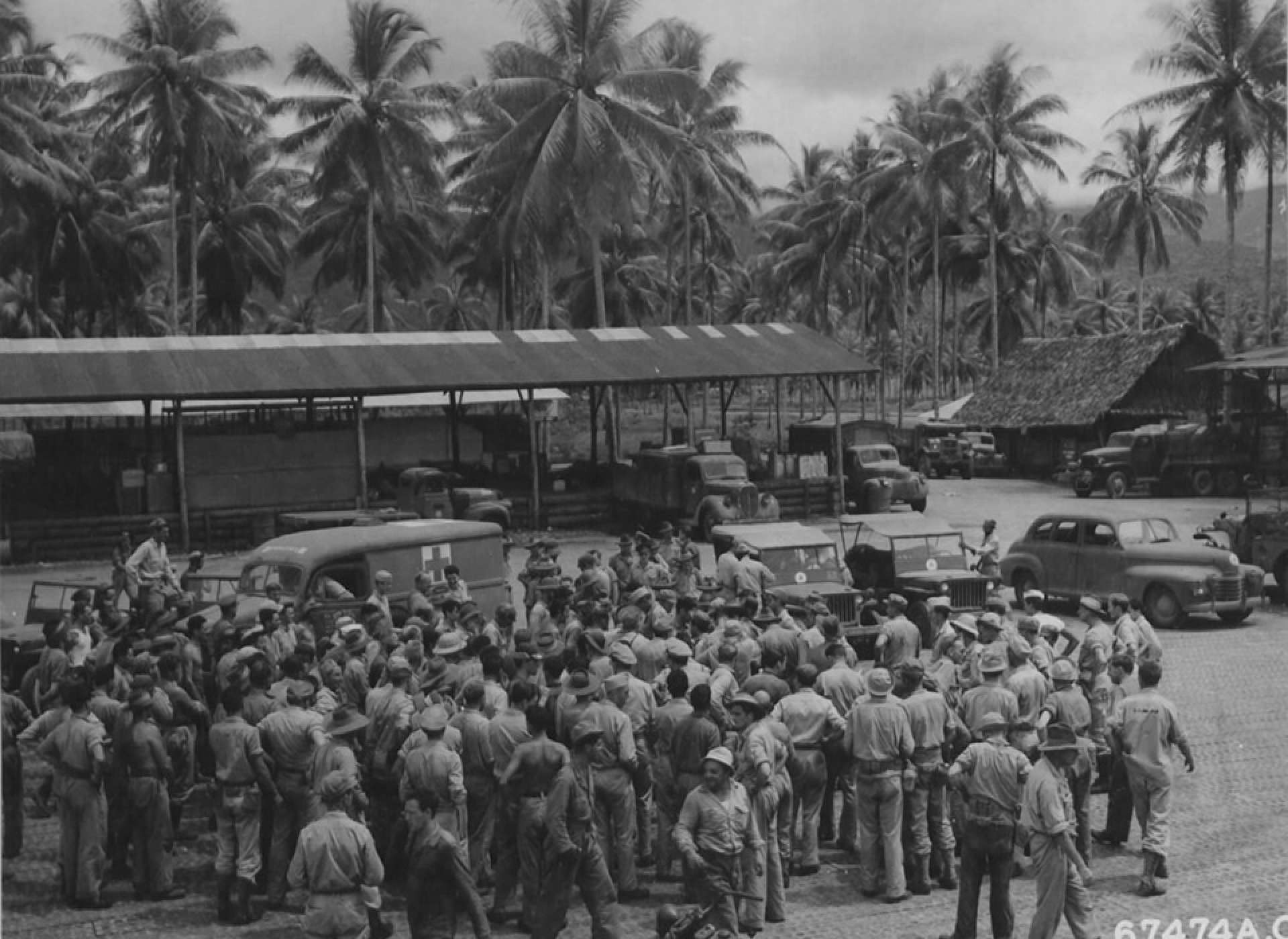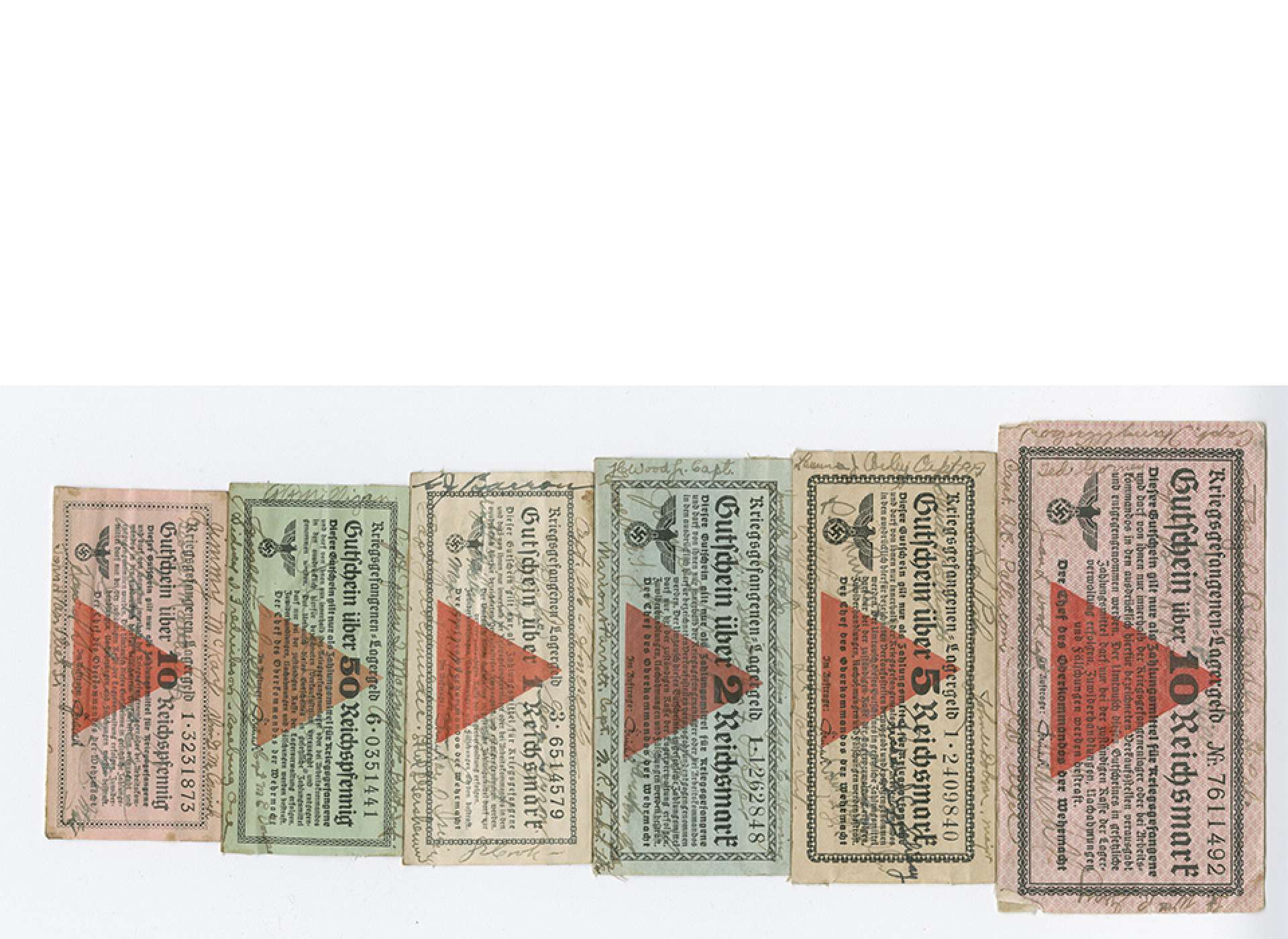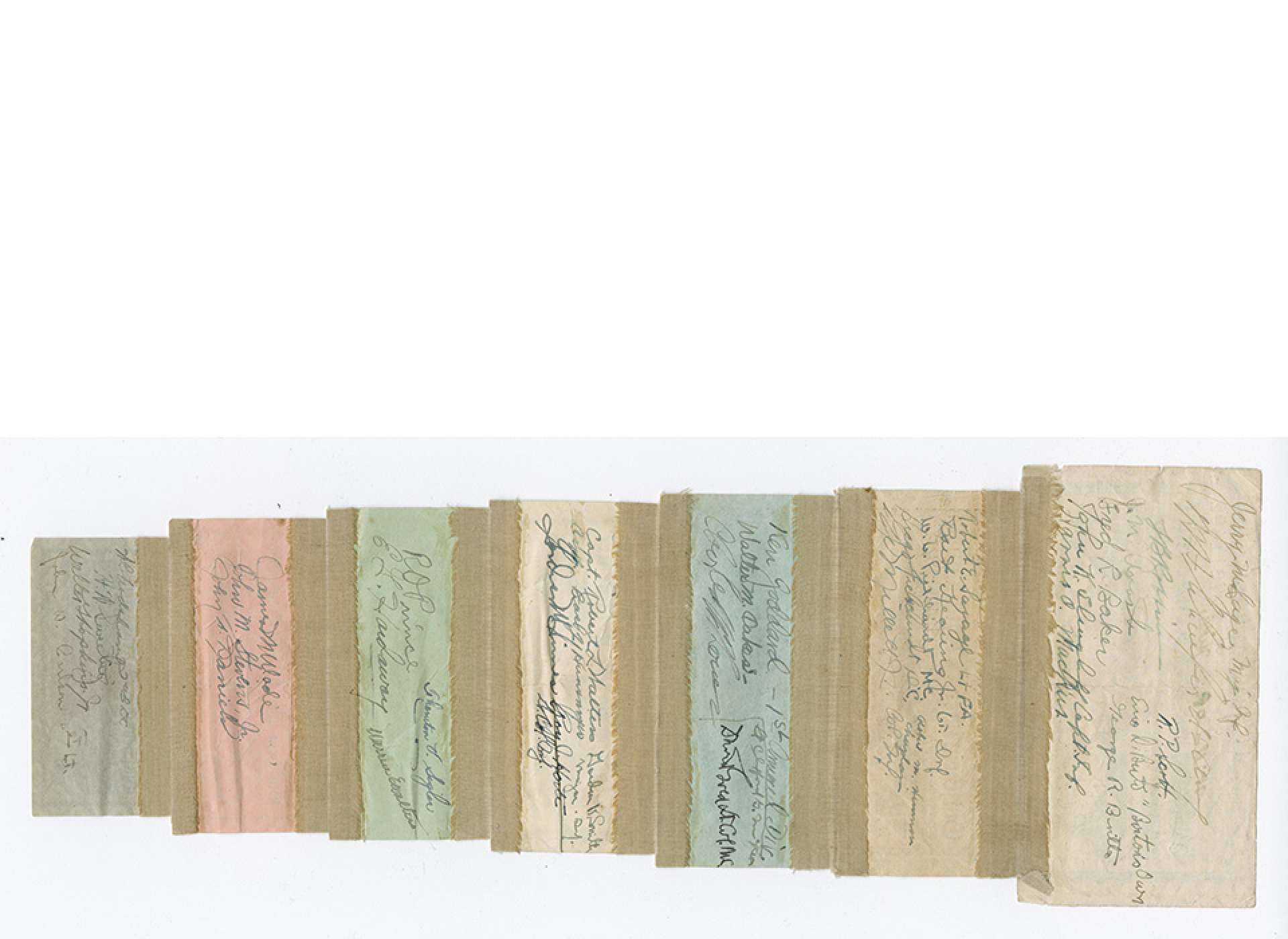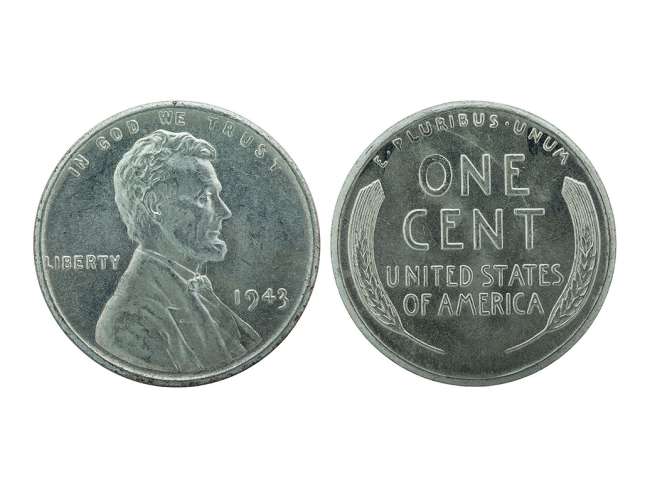Top Image: Actress and USO entertainer Martha O’Driscoll examines a long short snorter with unidentified Air Force officer and civilians. The National WWII Museum, Gift in Memory of Martha O’Driscoll, 2013.150.288.
American novelist and Nobel Prize winner John Steinbeck once observed that “very curious practices grow out of a war,” but he found none stranger than the oddly-named short snorter. Long ago, snort was slang for an alcoholic drink (swiftly swallowed), while short specified a smaller-than-standard measure. Thus, a short snort was a modest swig of hard liquor—a small shot, we might say today. But it was not wartime drinking habits that bothered Steinbeck as much as a semi-related craze involving the serial defacement of legal tender.
Housed in The National WWII Museum’s artifact collection are scores of signed souvenirs that US soldiers, sailors, and airmen collected overseas during the war. Among them are many varieties of autographed banknotes and, in some instances, streamers of bills stretching several feet long and sporting currencies from all over the globe. There are skillings from Greenland, schillings from England, Libyan lire, and Lebanese livre; cents and centavos taped to pounds and pesos, as well as dollars and drachma to yuan and yen.
Whether notes of invasion, occupation, or liberation, American GIs saved foreign and military issue currency as both a sign of their worldliness and as a record of their exploits. Though many types of these artifacts exist, each is a symbol of shared experience and—with the proper context—tells a unique story of an individual’s service. The Museum has been fortunate enough to acquire over 100 samples of these mementos, which are commonly referred to as short snorters.
Which raises the question:
What is the connection between knocking back a stiff drink and the ink-stained banknotes that Steinbeck scorned?
Well, the origins of the short snorter remain uncertain, but we do know that the practice of swapping signed dollar bills predated World War II and was initially an esoteric ritual performed by pilots. Alcohol generally followed.
The History of Short Snorters
In the days before federal regulations outlawed flying planes under the influence, pilots discovered that the combination of heavy alcohol consumption and aircraft operation proved unadvisable. Flyboys that swilled down strong spirits before taking to the skies tended to not live very long. As such, they imbibed only modestly before flights or during stopovers, and soon started jokingly calling each other “short snorter.” But what did this have to do with affixing signatures to paper money?
Enter the sensational stunt aviator of the Flying Gates Circus, Jack Ashcraft. Some attribute the start of the tradition to Alaskan bush pilots of the 1920s, but the most compelling explanation can be traced to a particularly successful evening for Ashcraft’s flying troupe in Syracuse, New York after a 1925 performance.
The story goes that the joint owners of the circus, Van Gates and Clyde Pangborn, dispatched Ashcraft and a fellow barnstormer in separate aircraft to a nearby winery in search of champagne. Despite being in the middle of prohibition, the pair planned to host a massive party in celebration of their recent success. Apparently, Ashcraft’s partner in crime returned promptly with his share of the bubbly, while Ashcraft got sidetracked by more attractive prospects—the sultry sort.
Ashcraft returned the following day. To avoid a scolding for his short-sighted slip up, he let Pangborn in on a sneaky scheme of his own design. “Gimme two bucks,” Ashcraft demanded before his superior could admonish him. Pangborn searched his suit and forked over a dollar bill and a piece of stage money. The sly pilot signed the fake bill “Short Snorter No. 1,” dated and handed it back to his boss, and pocketed the real one. “Now you’re a short snorter,” Ashcraft asserted. With that, he gave Pangborn the authority to induct new recruits—and score a buck for each one secured.
From there, the simple swindle spread and spawned a fraternal organization of flying scammers called the Grand Order of Unbenevolent, Purely Mercenary, Short Snorters. Whether the sham survived in the snowy reaches of Alaska or the sunny beaches of Miami, the group eventually codified a set of rules and regulations that also outlined membership qualifications. Seasoned fliers were quick to exploit the ruse and take stacks of cash off naïve newcomers.
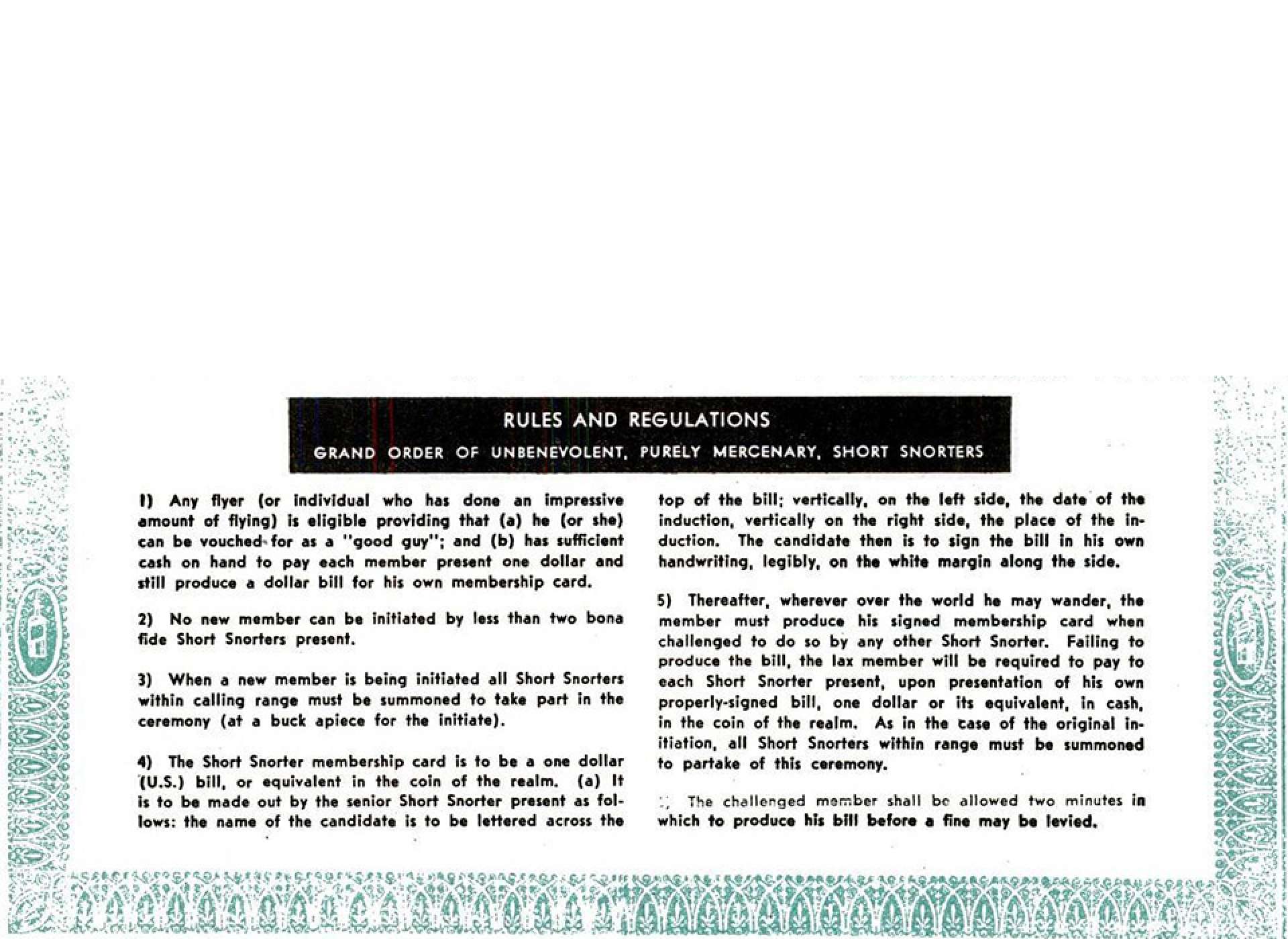
The official rules and regulations governing the short snorter club as published in a popular aviation magazine. Flying, Vol. 34 No. 2, February 1944, pp. 57.
Short Snorters in Service
Membership in the club exploded during World War II as a staggering number of American servicemen and women sailed the seas and traversed the skies. In the process, the short snorter somehow became synonymous with completing transoceanic flights and then, more simply, with the crossing of a large body of water.
Eventually, anybody could join with the invitation of an established member, which made Steinbeck gripe, “The club is pyramiding.” He estimated that there were millions of short snorters inducted during the war with thousands of new additions each day.
At once, the short snorter evolved into something of a status symbol as well as a drinking game. Some competed to collect the longest chains or compile the most signatures while others used short snorters in a more social pursuit. Any member could demand another to produce proof of membership at any time.
The subject of the challenge was then obligated to show his signed certificate or suffer the consequences. This typically meant a standard dollar fine shelled out to all members present or a round of drinks, which reaffirmed the association with alcohol. Coca-Cola even appropriated the concept but suggested that innocent soda sipping frequently followed a short snorter showdown.
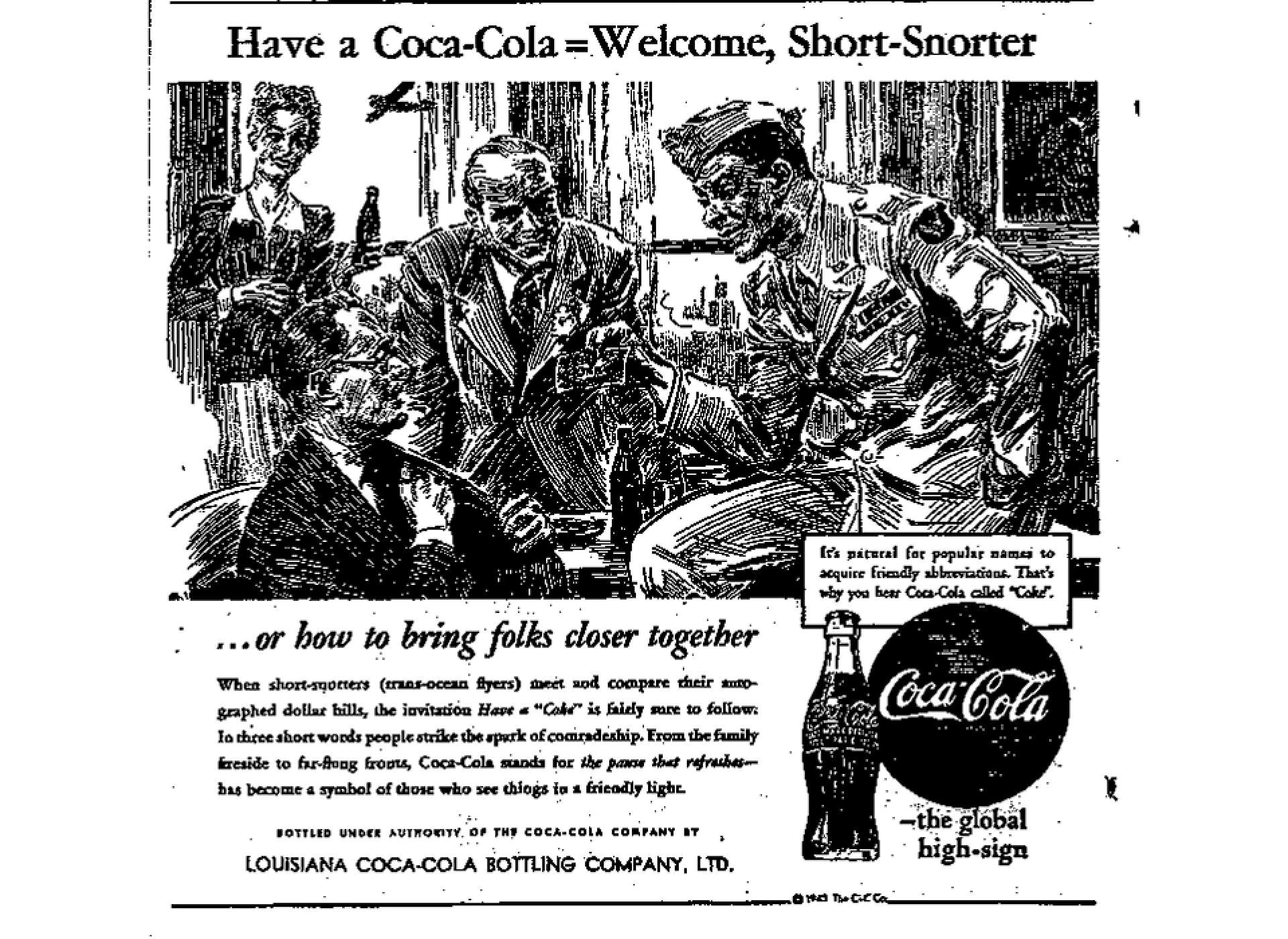
Coca-Cola embraces the spirit of the short snorter tradition. Times Picayune, September 29, 1943.
Examples from the Collection
Many examples of short snorters survived the war and subsequent decades to arrive safely at the Museum. As artifacts, they are useful because they can supply a snapshot of someone’s service: They occasionally list sorties flown or battles fought and reveal places visited or people encountered.
In that regard, they might help substantiate details of a veteran’s story uncovered in other sources or provide the foundation for further research. However, by seeing beyond what is scribbled on the surface, one can glean more about wartime methods of documenting experience and how troops dealt with the stress and uncertainty that war engendered.
For New Orleans native and Women’s Army Corps veteran Hilda Iverson, the 15-note short snorter she carried evoked special memories of stealing rides into town and strolling the streets in faraway lands. Like a portable logbook, her short snorter became a visible representation of the places she sojourned and could remind her of the time she glimpsed the pyramids as she flew across Egypt or when an accommodating pilot “buzzed” India’s Taj Mahal in the resplendent moonlight.
-

The front and back of Hilda Iverson’s 15-note short snorter. The represented currencies illustrate many of the places she traveled during the war, with a few notes added in from her brother’s service in the Pacific. The National WWII Museum, Gift of Hilda Iverson, 2001.089.033.
-

The front and back of Hilda Iverson’s 15-note short snorter. The represented currencies illustrate many of the places she traveled during the war, with a few notes added in from her brother’s service in the Pacific. The National WWII Museum, Gift of Hilda Iverson, 2001.089.033.
-

The front and back of Hilda Iverson’s 15-note short snorter. The represented currencies illustrate many of the places she traveled during the war, with a few notes added in from her brother’s service in the Pacific. The National WWII Museum, Gift of Hilda Iverson, 2001.089.033.
-

The front and back of Hilda Iverson’s 15-note short snorter. The represented currencies illustrate many of the places she traveled during the war, with a few notes added in from her brother’s service in the Pacific. The National WWII Museum, Gift of Hilda Iverson, 2001.089.033.
-

The front and back of Hilda Iverson’s 15-note short snorter. The represented currencies illustrate many of the places she traveled during the war, with a few notes added in from her brother’s service in the Pacific. The National WWII Museum, Gift of Hilda Iverson, 2001.089.033.
-

The front and back of Hilda Iverson’s 15-note short snorter. The represented currencies illustrate many of the places she traveled during the war, with a few notes added in from her brother’s service in the Pacific. The National WWII Museum, Gift of Hilda Iverson, 2001.089.033.
-

The front and back of Hilda Iverson’s 15-note short snorter. The represented currencies illustrate many of the places she traveled during the war, with a few notes added in from her brother’s service in the Pacific. The National WWII Museum, Gift of Hilda Iverson, 2001.089.033.
Three-war veteran and radar specialist Robert Small used a portion of his 34-bill streamer to immortalize the time he met famed entertainers Bob Hope and Gerardo “Jerry” Colonna. Steinbeck criticized the silliness of serious-minded men scrambling to procure the autographs of politicians, movie stars, and singers, but he failed to see how it lifted peoples’ spirits.
Throngs of enlisted men and women excitedly gathered to have celebrities sign their “new autograph books,” as Steinbeck styled them. These engagements did so much to enhance morale that high-profile personalities even carried their own short snorters to show solidarity with the troops.
-

This piece of Allied Military Currency, often called a “flag ticket” franc, was signed by renowned entertainers Bob Hope and Jerry Colonna. The National WWII Museum, Gift in Memory of Robert Meredith Small, 2019.354. 001
-

This piece of Allied Military Currency, often called a “flag ticket” franc, was signed by renowned entertainers Bob Hope and Jerry Colonna. The National WWII Museum, Gift in Memory of Robert Meredith Small, 2019.354. 001
-

A crowd of eager servicemen gather around American actor Gary Cooper to have their short snorters signed. Courtesy of the National Archives, 204956576.
On a more personal note, short snorters enabled soldiers to mark momentous occasions. Such was the case for Dr. Delbert Zane Schlemmer of the 508th Parachute Infantry Regiment, who jumped with the 82nd Airborne Division behind enemy lines in the early morning hours of June 6, 1944. On D-Day, Schlemmer carried with him an invasion note issued for use in Normandy at the departing airfields in advance of the operation. Fellow paratroopers helped memorialize that historic day by signing his bill, as did Pierre Cotelle, the Norman farmer on whose property Schlemmer landed.
On one of the most critical days of the war, two men from different parts of the world and speaking different languages were able to forge an enduring friendship on the front of a fifty-franc bill. Cotelle later commemorated that moment by naming the collection of artifacts he discovered in his fields “Musee Zane Schlemmer,” and Schlemmer held onto his memento for more than half a century before finally entrusting the Museum to care for it in perpetuity.
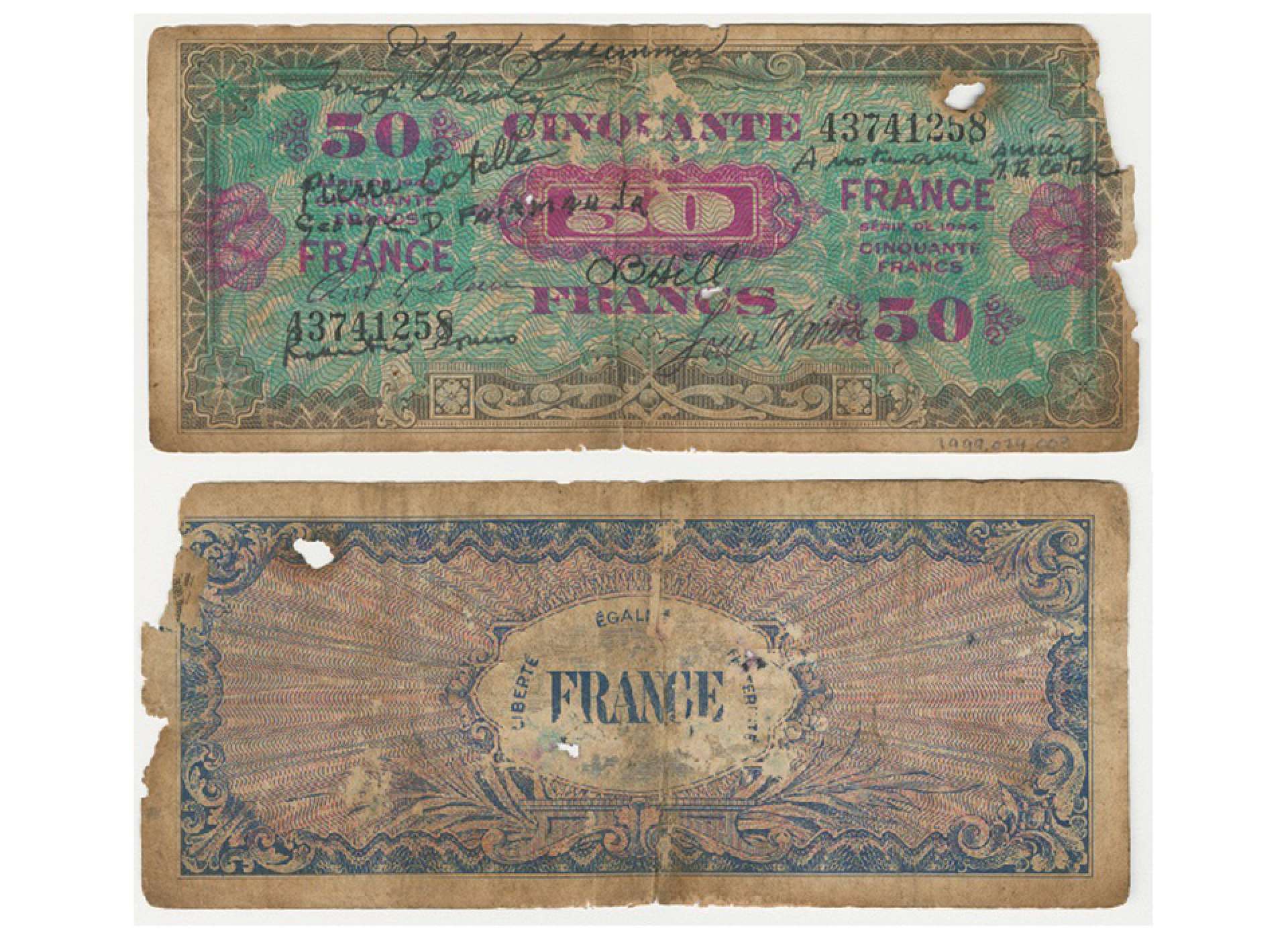
One of the earliest short snorters donated to the Museum is Dr. Schlemmer’s fifty-franc note. Pierre Cotelle’s name appears beneath the number 50 on the left-hand side. The National WWII Museum, Gift of Dr. Delbert Zane Schlemmer, 1999.024.003.
Major Newton Cole, a Division Chemical Officer in the 29th Infantry Division, also participated in the Battle of Normandy but was captured on June 19, 1944 (D+13). One of the 1,500 prisoners sent to German POW camp Oflag 64, Cole endured many months of misery and malnourishment. For men in his position, a short snorter could be a tool used to overcome the pangs of hunger and hopelessness that camp life induced.
Only redeemable in the poorly stocked camp canteen, his Kriegsgfangenen Lagergeld (literally this means POW camp money) served a more significant purpose than its intended use. After his liberation, it became a memento of the tribulations and trauma he shared with the other officers who signed his script.
-

The front of Newton Cole’s POW short snorter made with scrip of different sizes and denominations. Often rendered worthless by the lack of goods they could purchase, lagergeld had little value for prisoners. Some used them as gambling tokens to overcome boredom. Cole used his to capture the signatures of fellow officers in the camp that experienced similar circumstances and suffered similar traumas. The National WWII Museum, Gift of the Men of Oflag 64, 2006.130.018.
-

The back of Cole’s short snorter with additional names of fellow POWs. The National WWII Museum, Gift of the Men of Oflag 64, 2006.130.018.
Paper money makes the ideal souvenir. Banknotes have an intrinsic financial value, take up little space, are often aesthetically pleasing, and contain cultural and historical nods to their country of origin. They are tangible reminders from elsewhere that can summon powerful memories, spark meaningful conversation, and—in the case of short snorters—support research and discovery.
The cynic Steinbeck lamented the loss of humor that distinguished the early stages of the short snorter tradition, but he also failed to understand the motivation for and meaning behind the wildly popular practice during the war. He cared more about how many banknotes the fanatical collecting kept out of circulation than the personal value they held for the people to whom they belonged.
Indeed, bank managers often refused to deposit clearly marked short snorters in their vaults. They ran ads in local papers to try and return them to their rightful owners because they understood that the sentimental value of these keepsakes far outweighed their financial worth. These blemished banknotes may have lost their purchasing power after a while, but they certainly enriched their owners in far more important ways.
Today, short snorters are valuable research tools, but they are also powerful reminders of the geographic expanse of the war, the selfless sacrifices made by all the Americans who served across the planet, and the unity of purpose, camaraderie, and light-hearted fun that carried veterans through one of the most disruptive and destructive conflicts in modern history.
Chase Tomlin
Chase Tomlin is an Associate Curator at The National WWII Museum.
Cite this article:
MLA Citation:
APA Citation:
Chicago Style Citation:
